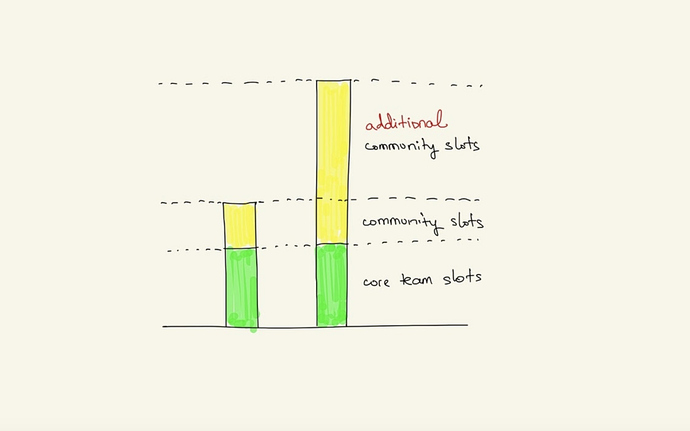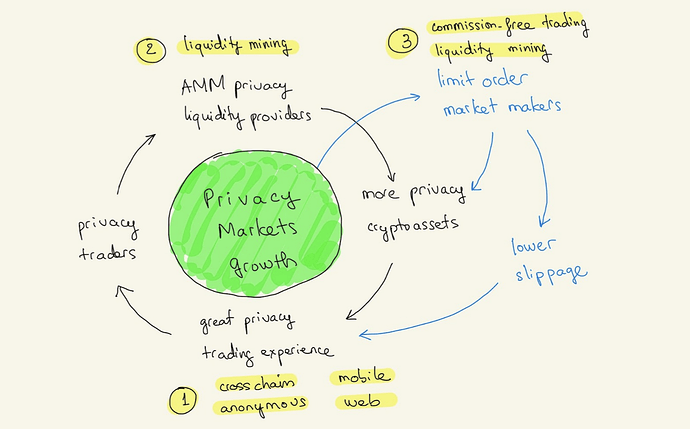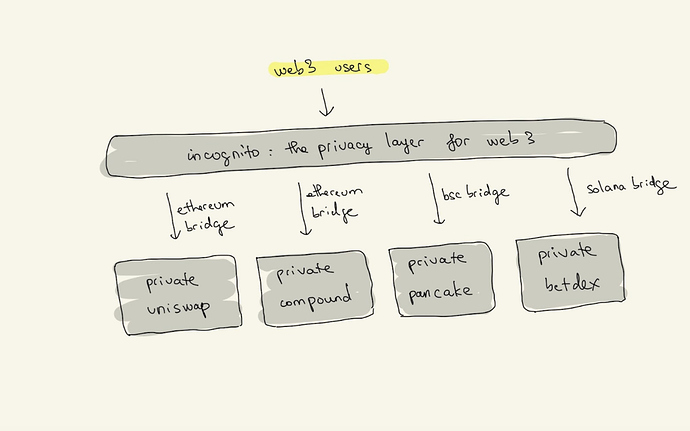Hello privacy people.
In 2018, we wrote the first lines of code for today’s world. In 2020, we launched the first privacy-preserving crypto exchange. In 2021, crypto exploded, and so did surveillance, targeted crime, and loss of freedom.
Here what’s next.
2021 Reflection: The first $500M
Incognito builds privacy infrastructure for the decentralized web, designed to scale as the need for privacy grows. This year, the network processed more than half a billion dollars of anonymous trades, launched multiple decentralized bridges, and released a number of technical improvements.
| Real-world adoption | Trustless interoperability | Network milestones |
|---|---|---|
| $500M+ traded (+1937% YoY) | Decentralized BTC bridge | Privacy v2 |
| $400M+ shielded (+1324% YoY) | Decentralized ETH bridge | Slashing v2 |
| 113 currencies shielded | Decentralized BSC bridge | Staking flow v3 |
| 2,000+ validators |
2022 Execution: The next $5B
The core team will focus on 3 key areas: privacy infrastructure, privacy markets, and privacy applications. Here’s the upcoming release schedule.
 |
Privacy Infrastructure (Decentralization) | Privacy Markets (Growth) | Privacy Apps (Utility) |
|---|---|---|---|
| January | Limit Orders | pPancake | |
| February | Reduce fixed node dominance from 66% to 45% | Liquidity Mining | |
| March | Web Wallet | ||
| April | Web DEX | ||
| May | Reduce fixed node dominance from 45% to 34% | ||
| June | Rebate Mechanism |
1: Privacy Infrastructure for Web3
The #1 focus for this area is decentralization. Incognito is technically decentralized with 2,000+ nodes across 8 shards. But it is not yet operationally decentralized. The core team still maintains ⅔ +1 seats in each shard for one single reason: to make sure that the network is fully tested and stable.
Starting Feb 2022, Incognito becomes truly community-driven. We can move forward more confidently now that essential milestones have been achieved. In 2021, slashing went live and improvements to the staking flow were released. Next, we are increasing the number of seats in each shard and transferring consensus from the core team to the community.
Fixed node dominance reduction
As previously mentioned, Incognito will increase the committee size, you can about the benefits here: Benefits of increasing committee size and answers to FAQ
The estimated rollout for this is March 18, 2022.
Blockchain storage reduction
The team was working on 3 different solutions for reducing blockchain storage:
- Removing beacon raw blocks, storing blocks in flat files, and optimizing empty block size.
- Using a batch commit mechanism for shard state data (it’s expected to reduce 50% shard state data size)
- Using optimized lite StateDB for shard state data (it’s expected to reduce 20% shard state data size)
The three above solutions are optional, a node may decide to run with an option it prefers with a tradeoff between data availability and storage size. Blockchain storage reduction would be a premise for block time reduction (so does decrease transaction latency). The ETA is March 31, 2022
Highway P2P PoC
Research has begun on allowing anyone to run a highway for Incognito to aid in decentralization.
After the research is complete we will move to the design & documentation phase followed by the PoC (Proof of Concept). Design & PoC is estimated to take ~8 weeks time and will begin at the start of March.
Bulletproofs:
Research on improving transaction verification performance by seeking Bulletproofs alternatives. Also, the team is also re-implementing the current Bulletproofs with a faster programming language (cgo) to see if it could help improve the Incognito privacy layer’s performance. ETA 18 April 2022
Transaction size:
Reduce transactions’ size by implementing new methods for marshalling/unmarshalling transactions when storing in the database. ETA 18 March 2022
One Time Shielding Address for Bitcoin bridge:
At the moment, shielding experiences the problem of address re-using. That is, the locking address for all shielding requests from the same user is the same. Fortunately, this problem can easily be solved by using one-time addresses.
2: Privacy Markets
The #1 focus for this area is growth. Incognito is the first cross-chain privacy marketplace, built for web3 users to exchange assets without being spied on.
The 2021 growth loop: a great privacy-preserving trading experience → more privacy traders → more AMM liquidity providers → more privacy crypto assets. This growth loop processed over $550M anonymous trades in 2021.
The 2022 growth loop: fueled by limit orders. The Incognito exchange has been upgraded with a hybrid trading engine that combines the best of AMMs and traditional order books. Think of the traditional AMM design as a 2D curve. This hybrid design is a 3D curve, where each price point on the AMM curve now has depth (a list of orders at this price point).
Why a hybrid trading engine is better:
-
It reduces price slippage and impermanent losses that all AMM exchanges suffer.
-
It will result in more privacy cryptoassets, because it’s now much easier to add liquidity. Users don’t need to provide liquidity with a pair of cryptoassets. They can simply place an order at the price they want.
How we will grow liquidity:
-
Initially, all limit orders (by market makers) are commission-free. Swap orders (by market takers) pay the trading fee. A rebate mechanism to further incentivize market markers will be implemented later this year, from the trading fee paid by market takers.
-
A liquidity mining program for both Limit Order Market Makers and AMM Liquidity Providers will be introduced. The funds for liquidity mining will come from the DAO.
Improvement for proving Incognito exchange assets ownership:
Currently, the Incognito exchange is using an NFT token (access ticket term in the app) for a user to prove his/her ownership of an asset (added liquidity or placed limit order). Rather than using 1 token for each exchange’s asset that would need so many tokens when Incognito has more users, we will be using coins of the same token for that. Thereby, it will help mitigate overhead for blockchain, backend, and app processes.
3: Privacy Applications
The #1 focus for this area is utility. Incognito is the privacy layer that connects web3 users and decentralized applications across all blockchains.
Privacy for web3:
We believe in a richer world of interconnected networks, each benefiting from the other’s strengths. Not the winner takes all mentality of today’s economy. Incognito brings interoperable privacy to the table – our approach allows users to interact privately with any decentralized application on any blockchain.
Privacy for any web3 developer:
We want developers to continue building and innovating on their favorite platform – whether that’s Ethereum, Binance Smart Chain, or Solana – without sacrificing privacy for their users.
Privacy for any web3 user:
We want these users to have the choice of privacy. They should be able to use their favorite applications publicly or confidentially – whenever they want to buy, sell, spend, send, receive, lend, borrow, create, etc.
pUniswap 
The protocol and backend have both been completed already. The front end needs to be implemented and then it will be passed off to QC.
The estimated finish date would be March 9th, 2022.
pCurve 
pCurve development will begin after pUniswap is passed off to the QC team.
The estimated finish date should be March 18th, 2022.
Bridges 
 Polygon <>
Polygon <>  Incognito Bridge
Incognito Bridge
The Polygon bridge has been completed. 
QC will check over everything prior to releasing it to the community.
The community post can be read here: Incognito - Polygon Bridge
 Fantom <>
Fantom <>  Incognito Bridge
Incognito Bridge
Fantom bridge development has been completed.
Details about bridge can be read here: The Incognito <> Fantom bridge
Unified privacy tokens 
Supporting Unified privacy tokens is a very important focus of Incognito and will help to unify the same type of coin from various networks on Incognito (example: pETH, pWETH, peggedETH, etc). An in-depth post was made regarding it:
Unified Privacy Tokens and Interoperable Apps
As this is rather complex, the development window for researching, developing, coding, deploying, and testing bridge aggregators has been given 8 weeks and should wrap up around April 25th.
4: Other work
We’ll be keeping a close eye on what’s going on around us, and will make adjustments to the plan detailed above if necessary. We need your insights and ideas to explore how Incognito can do the most good.
1. Tell us which decentralized apps and use cases you want privacy for. We’re integrating with Pancake first, and we’re open to what’s next. Privacy for lending? For stablecoins?
2. Tell us which decentralized bridges we should build. We’re exploring projects with fast-growing communities like Solana, Cosmos, Polkadot; so their users can have privacy.
3. Tell us what you think about Privacy NFTs. From a technical standpoint, it’s possible to design and implement privacy-preserving NFTs. But is there a demand for it? We are not sure.
4. Tell us what you think about the new website. We’ll be launching it within the next couple of weeks. It will give more visibility to the work that has been done, and hopes to be more helpful for new crypto users. Let us know if there’s anything you think we should include.
5. Tell us what you think about the new app. We’ll be relaunching in a few weeks, and will also be posting previews and explainers leading up to the release. The goal is to improve the experience, so we’ll need your feedback. We hope these UI/UX and communication improvements will drive more adoption for Incognito.
6. Tell us what else you think we should do. So we can work on what the community wants.
App Performance:
The app dev team is having an “all hands on deck” mindset to tackle app performance issues. Their goal is a 50% reduction in app load times and a 50% increase in app menu / key changes.
This should be completed anywhere from Feb 14 - March 11 at which point will be passed off to Quality Control (QC) for further testing March 14 - 25 with production release available to the community directly after QC is complete.
Web version:
The Incognito app is currently the only interface for users to interact with the Incognito blockchain, the team will be building a web version to help increase accessibility. The estimated rollout for its first version (a.k.a a Web DEX) is April 29, 2022.
Help us build privacy for people.
To the community and to the 2,000 nodes powering the Incognito network: thanks for sticking by us while we completed foundational work on Privacy Infrastructure this year.
We’re super excited to finally start working on the next phases of Incognito: Privacy Markets and Privacy Applications. You know, privacy you can have, share, and use.
We hope you’ll join us.
The Incognito Core Team




